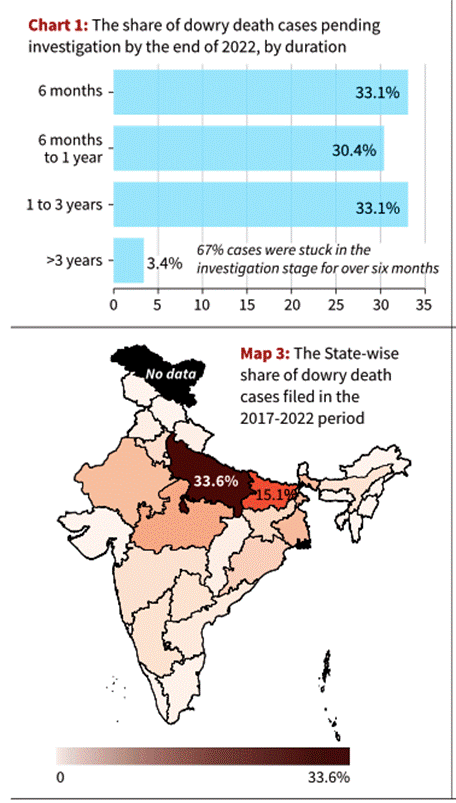Context
Despite being legally banned, dowry practices and related violence persist across India. A spate of recent cases — involving torture, suicides, and murders — underlines the systemic failures in prevention, investigation, and prosecution.
Relevance : GS 2(Social Issues)
Key Data: Dowry Deaths in India (2017–2022)
| Indicator | Value/Insight |
| Avg. Dowry Deaths Reported/Year | ~7,000 (NCRB data, likely under-reported) |
| Charge-Sheeted Cases/Year | ~4,500 (rest delayed or closed for lack of evidence) |
| Pending Investigation Cases (2022) | ~3,000, of which 67% pending >6 months |
| Delay in Charge-Sheet Filing (2022) | 70% filed after >2 months of investigation |
| Cases Sent for Trial/Year | ~6,500 |
| Convictions/Year | ~100 (⟶ conviction rate < 2%) |
| States with Highest Incidence | UP, Bihar, Jharkhand, MP, Odisha, WB, Haryana, Rajasthan |
| City with Most Cases (2017–22) | Delhi (30%), followed by Kanpur, Bengaluru, Lucknow |

Key Insights
1. Dowry Violence Is Rampant and Under-reported
- The 7,000 annual cases represent only the tip of the iceberg — social stigma, family pressure, and fear of reprisal prevent reporting.
- Cultural normalization of dowry demands continues, especially in patriarchal setups.
2. Investigations Are Slow and Incomplete
- Nearly half of the reported cases are not charge-sheeted.
- Delays in charge-sheeting (70% take >2 months) weaken the case and reduce chances of conviction.
3. Convictions Are Rare
- Less than 2% conviction rate despite FIRs and trial initiation.
- Acquittals, withdrawals, and plea bargains are common due to weak evidence, societal compromise, or prolonged legal processes.
4. Geographic Concentration
- 80% of dowry deaths are concentrated in 9 states, largely in the Hindi heartland and eastern India.
- Delhi alone accounts for 30% of dowry death cases among cities—reflecting both high reporting and severity.
Legal & Institutional Framework
| Law/Provision | Relevance |
| Section 304B, IPC | Punishes dowry death (within 7 years of marriage) |
| Section 498A, IPC | Cruelty by husband/in-laws for dowry |
| Dowry Prohibition Act, 1961 | Prohibits giving/taking dowry |
| CrPC Sections 174 & 176 | Mandate inquest/investigation into unnatural deaths of married women |
| NCRB Data | Captures only police-reported cases; no mechanism for socio-cultural reporting |
Challenges
1. Delayed Justice
- Investigation lags and evidence tampering compromise trials.
- Lack of forensic support and insensitive police response further aggravate the problem.
2. Social Pressures & Normalisation
- Silencing of victims due to family honour, fear, or economic dependence.
- Many families withdraw or settle cases informally, undermining justice.
3. Misuse vs Genuine Cases Debate
- Concerns over misuse of Section 498A IPC have led to dilution in enforcement.
- Judicial caution often overrides the urgency in genuine dowry harassment cases.
4. No Survivor-Centric Framework
- Lack of psychological, legal, and financial support for survivors and families.
- No centralised tracking of dowry cases from FIR to conviction.
Policy Recommendations
| Domain | Suggestions |
| Criminal Justice Reform | Fast-track dowry death cases; monitor time-bound charge-sheeting |
| Police & Forensics | Capacity-building in gender-sensitive investigation, forensic tools |
| Social Reform | Mass awareness campaigns; involve community leaders & youth groups |
| Survivor Support | Legal aid, rehabilitation funds, and safe shelter mechanisms |
| Data Transparency | Create a real-time national dowry case dashboard for monitoring |



